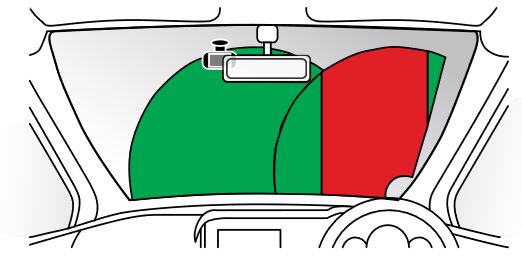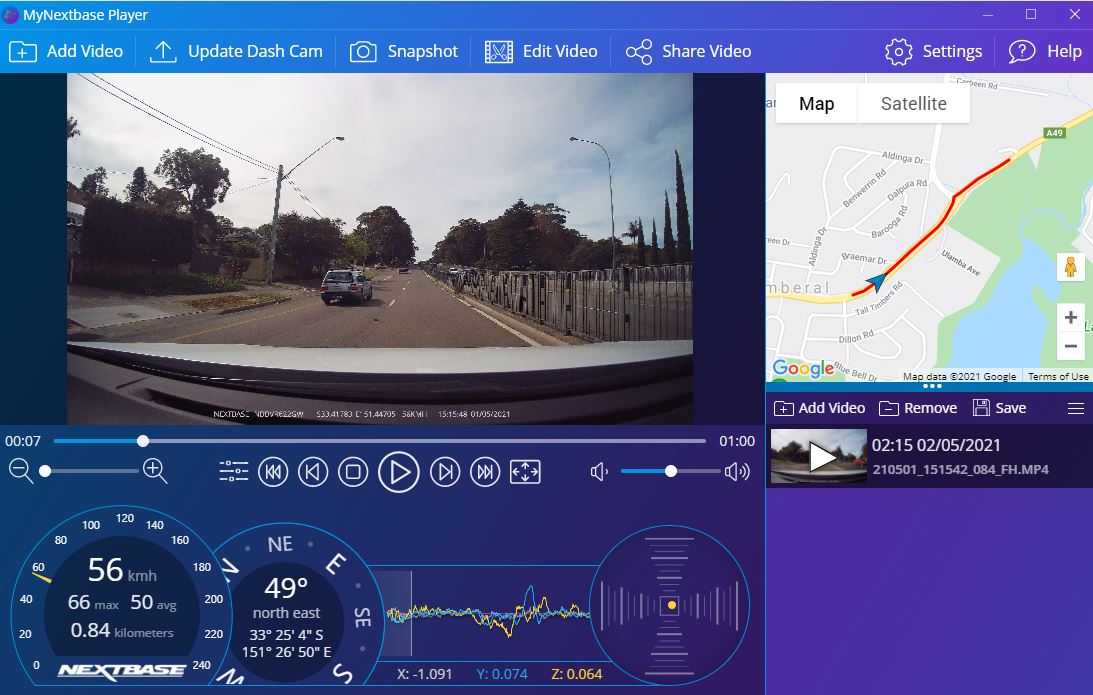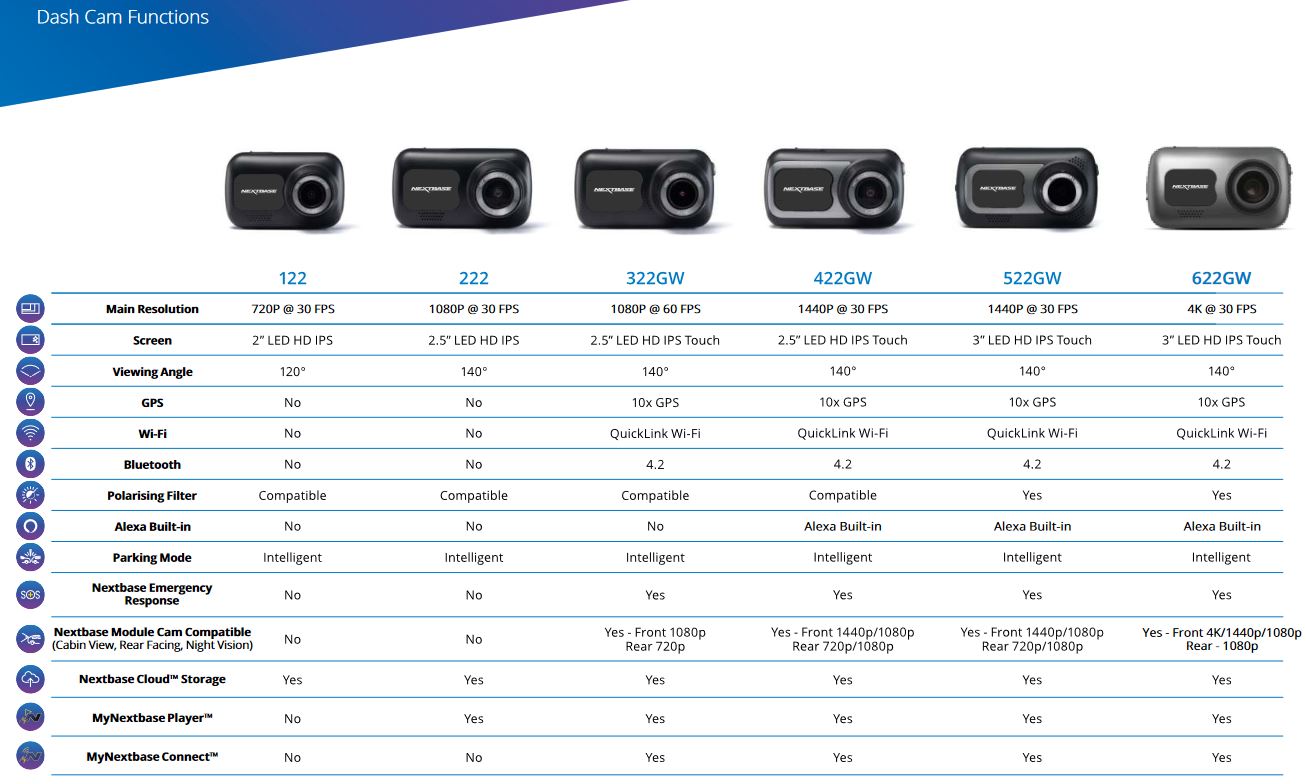The Nextbase 622GW 4K dashcam is a premium device with almost the ‘lot’. It has digital image stabilisation and extreme weather settings that could be the difference between a readable number plate or useless dashcam footage.
Now, most think a dashcam is a dashcam – wrong. You cannot begin to compare 4K image quality with an el-cheapo 1080p or 720p. If there are two things this review has taught me, it is 4K or nothing – and that is often not good enough. 4K recording is also memory hungry – a U3 (4K capable), 64GB holds about three hours recording.
The Nextbase 622GW 4K dashcam also adds some image smarts like aforementioned digital stabilisation, enhanced night vision, extreme weather mode (see through fog – not tested), and the Nextbase Suite for smartphone connect, and so much more. It is also Alexa enabled.
Top that off with a range of mounting accessories, rear camera options, and it is a complete package.
It gets GadgetGuy’s recommendation. Although it is not perfect and our reviews aim to inform you of both its strengths and weaknesses.
Review: Nextbase 622GW 4K dashcam
- Website here
- Manual here (it is a PDF, so check downloads)
- Price: $549.99
- Warranty: 12-months Dashcam and 6-months accessories, ACL compliant
- BT and Wi-Di connect
- Country of manufacture: China
- Nextbase UK (Est 1999) design and manufacture high quality, affordable, portable entertainment systems and dashcams. It designs for the UK market based on customer feedback and development. It pioneered a 12% insurance discount and acceptance as evidence in the UK if you installed one of its dashcams.

First impression
It has a 3″, 960×480 (480p), 16:9 rear touch LCD screen that shows accurate if a little muted colours and weather conditions. It is also to access settings, and it must not distract the driver. Nextbase recommends mounting it behind the rear vision mirror.
It has quite a sizable 8MP ‘turret’ lens at the front.
Unlike many other dashcams, it uses a traditional lithium-ion rechargeable battery instead of a ‘super capacitor’. This enables the ‘park mode’ bump monitoring when the car is parked.
The dual antenna GPS (found on the more expensive smartphones) is accurate within a couple of metres. That provides overlay information on the recorded video.
It comes with both a 3M, double-sided tape, stick-on mount and a suction cup mount. Both magnetically clip onto the dashcam so you can remove it without removing the mount – excellent.
The only item you need to buy is a U3 microSD card up to 128GB (6 hours recording). Nextbase recommends its cards as third-party cards can cause issues. My take is that any quality micro-SDXC UHS U3 V30 with a minimum of 30Mbps sequential write speeds is OK.
Note that due to the relatively high rate of writing and overwriting, microSD cards used in dashcams have a higher failure rate. It is wise to format the micro-SD card regularly and rotate spares.
Setup
Not much to do at all. Choose your mount, place it as high as possible on the windscreen, plug in the utility socket cable to mini-USB, and insert the microSD.
It draws 5V/1.5A/7W. It can run it off most standard USB-A 2.0 ports in a car or computer. Remember, the tiny 370mAh battery is only for ‘park mode’.
All you need to know is where the red ‘Protect’ button is. It saves images from overwriting when the microSD is full. You can tap the centre of the screen to take a photo. A mic records everything said in the car – you can turn it off.
Nextbase Accessories
It offers both cabin view and rear-view cameras that click into the side of the dashcam.
There is a rear window camera with a 6.5m cable to the front camera’s video port. These all reduce the resolution of the front camera.
Mounting
Nextbase suggests high as possible under the rear vision mirror. But that means a cable needs to ‘hang down’ unless you can route it around under the roof lining and via the side pillars etc.

While it comes with a cable tidy tool we strongly recommend that if you have a premium vehicle you use a professional installer or your car dealer (for warranty purposes). That is pretty much the same for most dashcams. A hardwire kit is $39.

App MyNextbase connect smartphone app – buggy and unreliable
It uses Wi-Fi Direct (Wi-Di) to join an Android or iOS smartphone via its 2.4 or 5Ghz SSID. We achieved 433Mbps link speed which is very much faster than mini-USB data transfer.
But we had a variable experience with many dropouts despite testing with a top of the range Samsung Galaxy S21 Ultra. We were unable to play files in the app (error message – not supported). The other issue is that you lose mobile broadband or Wi-Fi smartphone internet connectivity while connected to Nextbase. If you read user reviews, the smartphone app is by far the biggest bugbear.
The app is appalling. The camera itself records fantastic quality video but getting the app to work to access the videos is absolutely shocking. Nine times out of ten, it won’t connect to the camera and even if it does, actually downloading the video is still a challenge.

Fortunately, you don’t need the app to use the device.
Smartphone app privacy
It uses location and storage and wants to always run in the background. We suggest you grant all three. If you limit background use only when the app is active, it may cause more issues.
Turn off Analytics and Marketing (App settings) for privacy and to avoid ads (although the app has prominent Nextbase ads)..
Alexa (not tested)
Alexa voice-enabled (minimal command list here) is of less use in Australia as we tend to use Android Auto or Apple CarPlay (not tested). Reader reviews also say this can cause audio dropouts.
Rear camera (not tested)
It can support a 1080p@30fps rear camera, and the dashcam still records at 4K@30fps.
The camera sensor reveals all
It has an Omnivision OS08A10 8MP CMOS sensor for action cams, security camera and drones. It is capable of shooting in 4K, 3840×2160@30fps, as well as 1080p@ up to 120fps.
You can manually adjust the resolution from 4K to 2K 2160×1440 (30/60fps) or 1K 1920×1080 (30/60/120fps). You may want to do this to increase storage minutes on the microSD.
It has 2um pixels (large) and can use 2×2 Bayer binning (combines several images to produce a 2MP image).
The 6-layer glass lens and the f-stop/1.3 – very wide – lets in a lot of light. By comparison, a smartphone usually has an f-stop from 1.8 to 2.4!
If you use the image stabilisation, extreme weather, and night options, you get a 2704×1520 pixel image cropped to 2K 2160×1440 (or smaller).
Nextbase is not lying – it is a 4K sensor, but the images will be lower resolution when image enhancements (binning) are enabled. This is the same for any brand of 4K device.
Image quality – OK to good
The lens has a polarising filter to reduce glare, and you MUST adjust the filter for maximum clarity.
Video recording is always active, but it breaks the clips into 1, 2 or 3 minutes. All images have a time, speed, and GPS stamp. Options include your car’s number plate and GPS model.
The 140°-degree camera does distort the edges and creates broken images (of power lines etc.), but that is not material. It is important because it relatively accurately records colours and a lot of detail – even if you can’t see it on a smartphone screen.
4K allows relatively close (3-6m away) images of number plates when zoomed in. But outside that range, it is no better than lesser devices. It is four times better than 1080p (1K).
Day use – reasonably detailed 16:9, colour accurate images. There is a slight but expected edge distortion with the 140° wide-angle lens. We could read number plates quite well to about 6 metres provided the car was within +/- 45° from straight on. In other words, the fisheye distorts images outside that.

Night use – we will update the images with night shots shortly, but it is not a 4K (8MP) Sony Exmor R STARVIS sensor with 2.9um pixels, so dashcams with this sensor will produce better low light images.
Image stabilisation mode – smooth the bumps
It electronically crops the 4K image to 2K to keep a stable horizon line. For most use, leave it off, but if you have harsh suspension or are using it in heavy vehicles or off the road, it is handy to help get the clearest image.
Extreme weather mode – or fog if you live in the UK
An option that bins (combines frames) to clear up an image or see further in fog resulting in a 2K image.
Park Mode – missed the action
The 370mAh battery allows the G-sensor to activate when bumped and record a 45-second protected video. But the cold boot (turn on) takes at least 6 seconds before it records the video, which means you don’t get the ‘pretext’ of the event or even the event itself.
We tested this mode by dropping the bonnet, and it did not activate. Later we found the G-sensor defaults to medium. The high setting works better in this mode but results in a lot more protected videos when you brake or go over a speedbump. Again a firmware update could fix this.
Emergency SOS (not tested)
It has a one-year free trial but the app does not indicate subsequent costs. We can only assume that it works with Australian emergency services.
It also requires a smartphone link via Bluetooth. If the dashcam detects a crash, the MyNextbase Connect app monitors key sensors in your phone. If you cannot call for help, it will automatically send a text with your last known GPS location, medical and vehicle details to the nearest Emergency Service.
Remember that if you wish to use video in court, you cannot edit it, and you must hand the original read-only SD card to the attending police as evidence to maintain the chain of evidence.
What3words – where are you
what3words divides the globe into 3m squares and gives each one a unique 3-word address. It means everywhere can be located with just three words as long as local emergency services support it.

Windows and Mac
You can access read-only video files over a USB cable or by plugging the card into a microSD card slot (chain of evidence precaution). When downloaded to a PC or Mac, they are editable.
A 45-second 4K@30fps video is about 300MB.
You can also connect the Nextbase 622GW 4K dashcam to a TV via a mini-HDMI to HDMI cable.
MyNextbase Player (Windows – we could not find a version for Mac)
It is an MP4 editor/player customised to work with GPS data and Google Maps. It can join 45-second clips and do basic editing.

The player/editor requires you to import the videos over USB or from the micro-USB (the manual states that this is faster) as they are read-only on the device. Importing 314 files (about 64GB) over mini-USB was painfully slow – over one hour, and you cannot do anything until all the clips download..
We used a Microsoft Surface Pro i7 16/256GB, and MyNextbase player was slow, unworkable and often went to a blank screen. It also chewed up most of the available memory.

Once you edit and save, you then delete the files and import a fresh batch.
As the file type is MP4, you can use Windows Media Player (or similar) to view the videos on the device – they are in a DCIM folder.
What it does not do
It does not have any ADAS (Advanced Driver Assist) functions like over speed, school zone warnings etc. Most GPS satnav units provide this function anyway.
Also is missing is an on-screen digital speed indicator. Again, most cars have a digital readout dashboard, but it is handy for you and your passengers (back seat drivers) to see the GPS speed readout.
A few issues
Over a two week test, the screen occasionally and irregularly froze – no update to the screen image. Neither the power button nor removing the power could fix that (as the battery has to run down first). There is a reset button and briefly depressing that fixes the issue but can wipe all settings.
The ambient temperature outside was 22° (autumn), but we measured nearly 50° at the GPS antenna during operation. We suspect the lock-ups are a temperature issue.
If you remove the microSD card while powered up, it can corrupt the card requiring a reformat. Remember to power off first.
You must use the smartphone app to get Emergency SOS and Alexa. The app must run ‘always’ in the background and may significantly impact smartphone battery life.
Mounting position and cable concealment is an issue that requires planning. If you mount it lower down, the mount’s angle adjustment is insufficient to clear the dashboard.
I would really like a GPS speed readout – it would be easy to incorporate it in a software update.
GadgetGuy’s take
The Nextbase 622GW 4K dashcam is a premium product, and while the review exposes a few weaknesses, there is no such thing as the perfect dashcam yet. Despite its launch in January 2020 in the UK, MyNextBase Connect and the editor still feel like they are a work in progress.
It does most things any other dashcam does. Images are clearer, the extreme weather mode (not tested) and image stabilisation are extra benefits.
It is one of the larger cameras – not a bad thing, but there are smaller discrete ones.
Would I buy it?
I tend to shop for premium, so the Nextbase 622GW 4K dashcam would be on my list. But I think there are a few issues that make it less of a class leader until addressed. It is just that everything did not work as flawlessly as I expect, and I would prefer a Sony STARVIS sensor in a $550 device.
Since mid-2108, I have used a mid-price Uniden iGo 80 4K costing about $250. It has not had a blip and has Wi-Fi, ADAS, and a terrific app. I can’t see the point in spending over twice that on the Nextbase until it is perfect.















